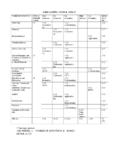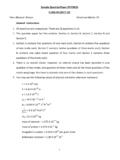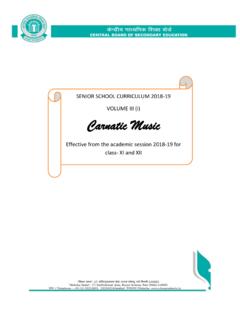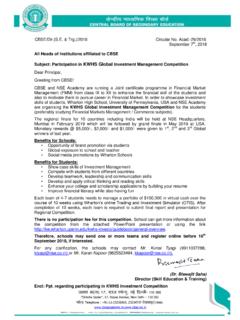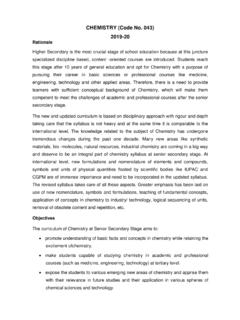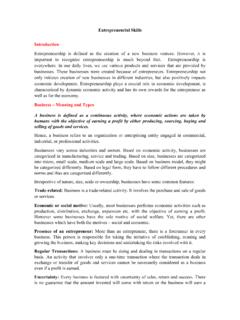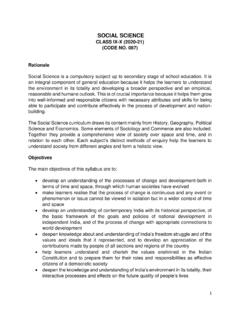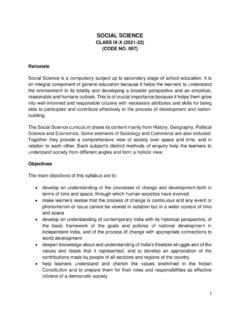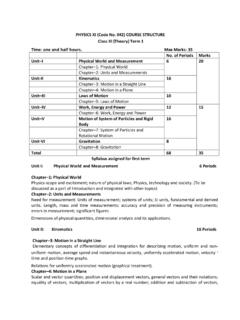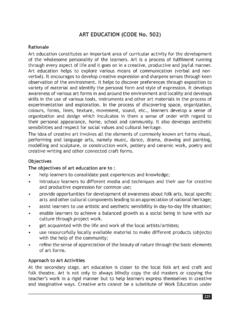Transcription of Table of Contents
1 AcronymsForewordBackgroundIntroduction to SAFALA ssessments at Key Stages: Examples from across the GlobePurpose of SAFAL in CBSE Schools SAFAL Pilot 2021-22 Key Features of SAFAL in 2021-22 Difference Between SAFAL, Board Exams and National Achievement SurveyAssessment FrameworkItem DevelopmentSample Items for SAFALS election and Capacity Building of SAFAL Item WritersReportingUse of Data and DisseminationRoles and Responsibilities of CBSEF uture Outlook3456891010111213141717202121 Table of ContentsCentral Board of Secondary EducationCentre for Development of Advanced ComputingFoundational literacy and NumeracyMinistry of EducationNational Achievement SurveyNational Assessment Program literacy and NumeracyNational Council of Educational Research and TrainingNew Education PolicyProgram for International Student AssessmentStructured Assessment For
2 Analyzing LearningCBSECDACFLNMoENASNAPLANNCERTNEPP ISASAFALA cronymsSAFAL - Structured Assessment For Analyzing Learning3 SAFAL - Structured Assessment For Analyzing Learning4 The National Education Policy (2020) is a comprehensive framework by the Ministry of Education (MoE) to ensure quality education in India. The policy recognizes high quality Foundational literacy and Numeracy (FLN) as an urgent and necessary prerequisite to learning. The quality of assessments in elementary grades can play a pivotal role in measuring progress towards achieving this goal and also provide guidance to each stakeholder in the system for improving learning levels.
3 NEP 2020 recommends transforming the assessment system to promote development of students and suggests a shift from testing rote memorization to competency-based learning. To map progress throughout school years, the NEP 2020 proposes an annual school examination for all students in Grades 3, 5, and 8. This assessment will focus on testing core concepts, application of knowledge and higher order thinking skills. Structured Assessment for Analyzing Learning levels (SAFAL) will ensure progress throughout school years by providing diagnostic information about students learning to schools and thus, support school education to move towards competency-based education.
4 The results of this assessment will largely be used to provide development feedback to schools and not for promotion of students to the next grade. CBSE invites all schools to participate in SAFAL in CBSE 26 July, 2021 ForewordSAFAL - Structured Assessment For Analyzing Learning5 Measurement of student learning outcomes is important for improving quality of education. Assessment is the process of gathering and evaluating information on what students know, understand, and can do. This can help students as well as educators, make an informed decision about the next steps in the education process (Clarke, 2012).
5 There are two kinds of assessment of students learning, used in different contexts and for different purposes:1. Individual assessments for students 2. System-level assessments or evaluations for schools, regions, or national education systemIndividual assessments for pupils can be formative to give feedback to learners and teachers on their skills and progress, or they can be summative, in the form of final grade examination results. Various large-scale regional, national, and international assessments are used to evaluate the output of a school system; and are designed to provide evidence about the levels of student achievement in specific learning domains.
6 A large-scale assessment system needs to address educational policy issues and - Structured Assessment For Analyzing Learning6In view of the New Education Policy 2020, key focus on skill-based and competency-based assessment, and of NIPUN Bharat, with its commitment towards improving the achievement of student learning outcomes in the foundational years, the Central Board of Secondary Education (CBSE) is planning to introduce a competency-based assessment to assess student learning outcomes on key competencies. The proposed name of the assessment is Structured Assessment for Analyzing Learning (SAFAL).
7 The assessment would be focused on the assessment of core competencies. SAFAL results would provide diagnostic data and insights to each school for promoting development of students. INTRODUCTION TOSAFALSAFAL - Structured Assessment For Analyzing Learning7 To track progress throughout the school years, and not just at the end of Grades 10 and 12 - for the benefit of students, parents, teachers, principals, and the entire schooling system in planning improvements to schools and teaching-learning processes - all students will take school examinations in Grades 3, 5, and 8 which will be conducted by the appropriate authority.
8 These examinations would test achievement of basic learning outcomes, through assessment of core concepts and knowledge from the national and local curricula, along with relevant higher-order skills and application of knowledge in real-life situations, rather than rote memorization. The Grade 3 examination, in particular, would test basic literacy , numeracy, and other foundational skills. The overall results of school examinations will be used only for developmental purposes of the school education system, including for public disclosure by schools of their overall (anonymized) student outcomes, and for continuous monitoring and improvement of the schooling system.
9 The Grade 3 SAFAL results will identify areas of intervention to imporve foundational literacy and numeracy among learners and help develop reforms for the NIPUN Bharat Mission. KEY FEATURES OF ASSESSMENTR elevant sections from National Education Policy 2020 pertaining to assessments at key stages: Test core concepts and move away from rote learningAssessments applicable for all Government and Private SchoolsSchool level data will be shared for development of learning outcomesData to be used for continous monitoring and improvementSAFAL - Structured Assessment For Analyzing Learning8 Key stage assessments are conducted around the world to provide a comparable school-level learning marker that could be used to improve learning outcomes.
10 Chile, Peru, Mexico, Australia, and the United Kingdom have adopted a census-based approach to learning assessments as a key pillar in their education reforms. The assessment tools and implementation standards are rigorous to ensure data reliability and enable effective use of learning achievement data. Some examples are below: The National Assessment Program literacy and Numeracy ( naplan ) assessment in Australia is developed using rigorous assessment frameworks based on competencies and proficiency levels. Test developers are engaged to develop items that meet test specifications, items undergo field trials and psychometric analysis before being selected for the final test instruments.
